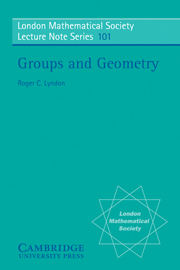Book contents
- Frontmatter
- PREFACE
- Contents
- Chapter I Symmetries and Groups
- Chapter II Isometries of the Euclidean Plane
- Chapter III Subgroups of the Group of Isometries of the Plane
- Chapter IV Discontinuous Groups of Isometries of the Euclidean Plane: Plane Crystallographic Groups
- Chapter V Regular Tessellations in Higher Dimensions
- Chapter VI Incidence Geometry of the Affine Plane
- Chapter VII Projective Geometry
- Chapter VIII Inversive Geometry
- Chapter IX Hyperbolic Geometry
- Chapter X Fuchsian Groups
- References
- Index
Chapter V - Regular Tessellations in Higher Dimensions
Published online by Cambridge University Press: 05 April 2013
- Frontmatter
- PREFACE
- Contents
- Chapter I Symmetries and Groups
- Chapter II Isometries of the Euclidean Plane
- Chapter III Subgroups of the Group of Isometries of the Plane
- Chapter IV Discontinuous Groups of Isometries of the Euclidean Plane: Plane Crystallographic Groups
- Chapter V Regular Tessellations in Higher Dimensions
- Chapter VI Incidence Geometry of the Affine Plane
- Chapter VII Projective Geometry
- Chapter VIII Inversive Geometry
- Chapter IX Hyperbolic Geometry
- Chapter X Fuchsian Groups
- References
- Index
Summary
Introduction
We have seen that there are exactly five types of regular tessellations of the 2-sphere S2, which correspond to exactly five types of regular solids in three dimensions. We have seen also that there are exactly three types of regular tessellations of the Euclidean plane E2.
It is natural to ask how many types of regular tessellations there are of Sn and of En for n ≥ 3. This question has a simple answer. There 3 are six types of regular tessellation of S3, and only three types of regular tessellation of Sn for all n ≥ 4, corresponding to the three (n+1)-dimensional regular solids that are the natural analogs of the 3-dimensional tetrahedron, the cube, and the dual to the cube, that is, the octahedron. There is only one type of regular tessellation of En for all 3 n ≥ 3, the natural analog of the tessellation of E3 by 3-cubes except for n = 4, where there are two more.
In the interest of intuitive visualization, we have for the most part confined these notes to 2-dimensional geometry, but it turns out that to discuss the regular tessellations in higher dimensions we do not need to depart far from this limitation. The only facts from higher dimensional geometry that we use follow in the most obvious way from the representation of En as the ‘coordinate space’ of all points
P = (x1,…,xn) where x1,…,xn are real numbers.
- Type
- Chapter
- Information
- Groups and Geometry , pp. 78 - 106Publisher: Cambridge University PressPrint publication year: 1985



